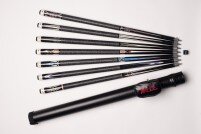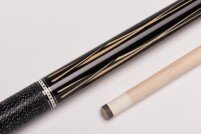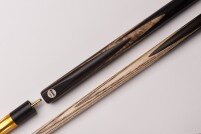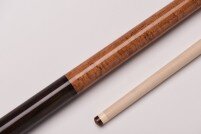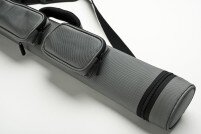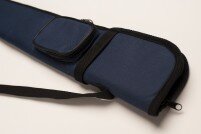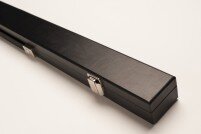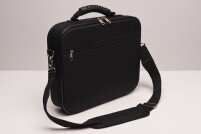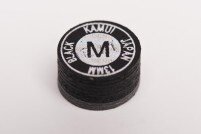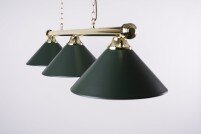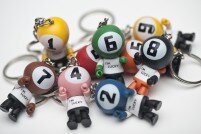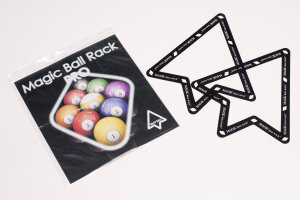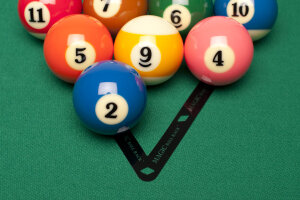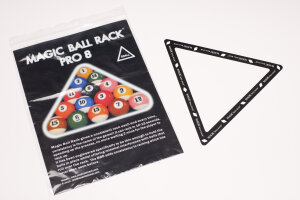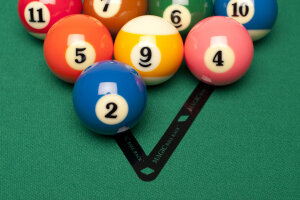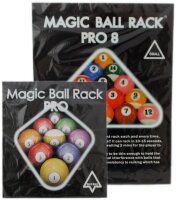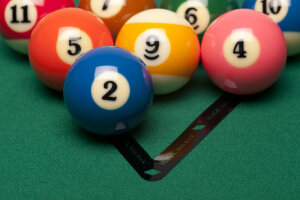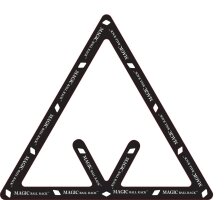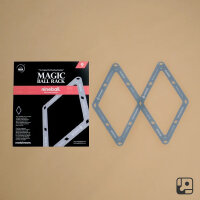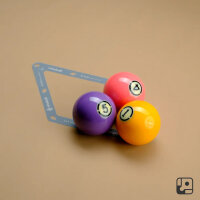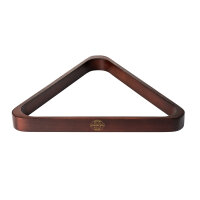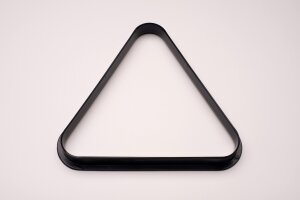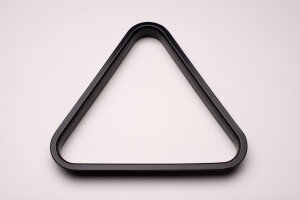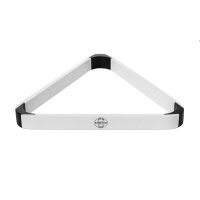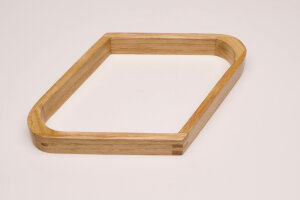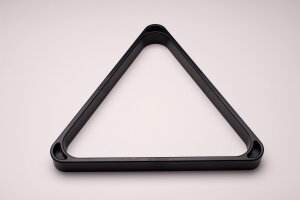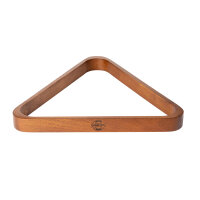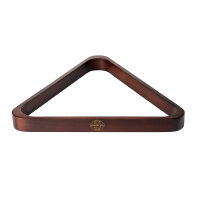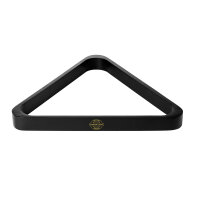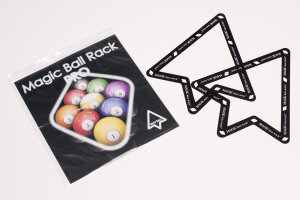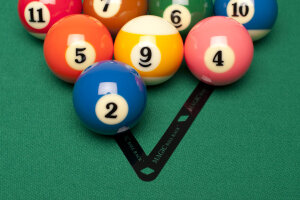Pool rules: rules and information about all popular pocket billiards variations
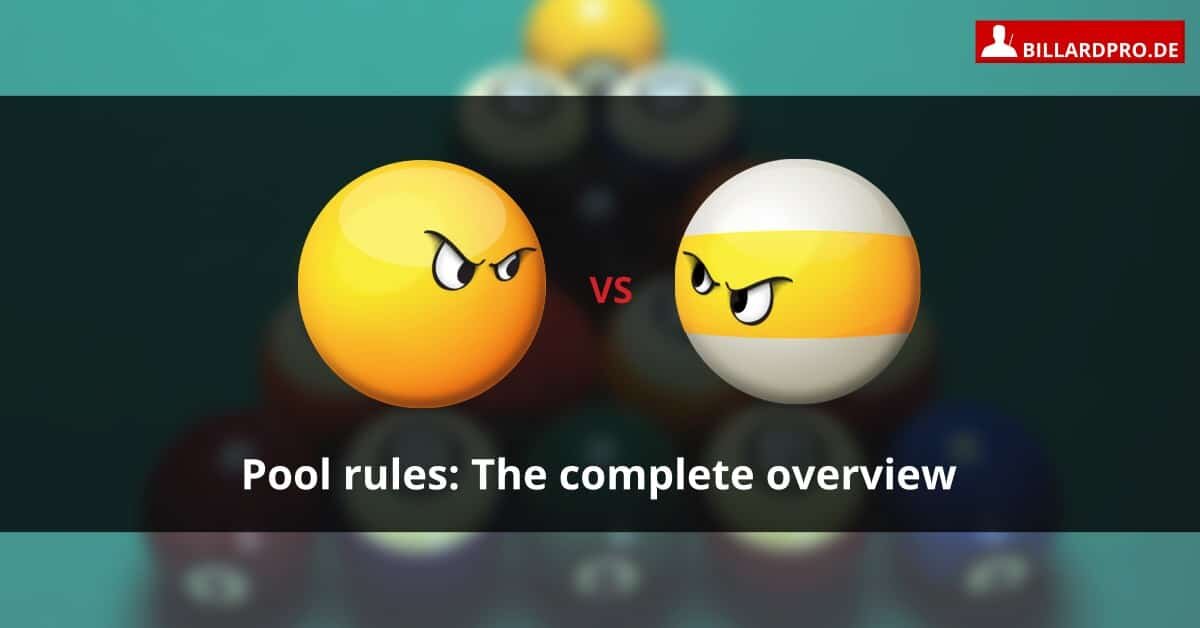
Does the black 8-ball have to go into the opposite pocket or into the same pocket as the last striped ball? In Straight Pool, how do you set up when the cue ball and the last object ball are in the triangle? Is it possible to win 10-ball with a combination? And what is a spot shot in the Philippine rotation? Some questions come up more often than others at the pool table. To be on the safe side, we’ll answer all of them in our ultimate guide to the rules and information for all common pool variations.
Table of contents
8-ball
8-ball is the most popular and widespread game variation in pool. It is played with all 15 object balls, which are divided into the groups of »solid« (1-7) and »striped« balls (9-15) and the black eight. The first regularly pocketed ball after the break decides which player plays which group.
8-ball is a called-shot game. Therefore, in order to pocket a ball correctly and continue to play, it must be called beforehand which ball is to be pocketed in which pocket. Combinations are generally allowed. A player must always hit one ball of his group first in order to make a correct shot. In the case of obvious shots, no call needs to be made.
Objective of the game
The objective of the game is to pocket all the balls in your group and then the black eight ball. The pocket for the eight ball must be called, but may be re-selected for each attempt. According to the official rules of the WPA (World Pool Association), the eight ball does not have to be played into the same or opposite pocket of the last pocketed ball. However, such rule variations are quite possible and common.
How to rack the balls
-
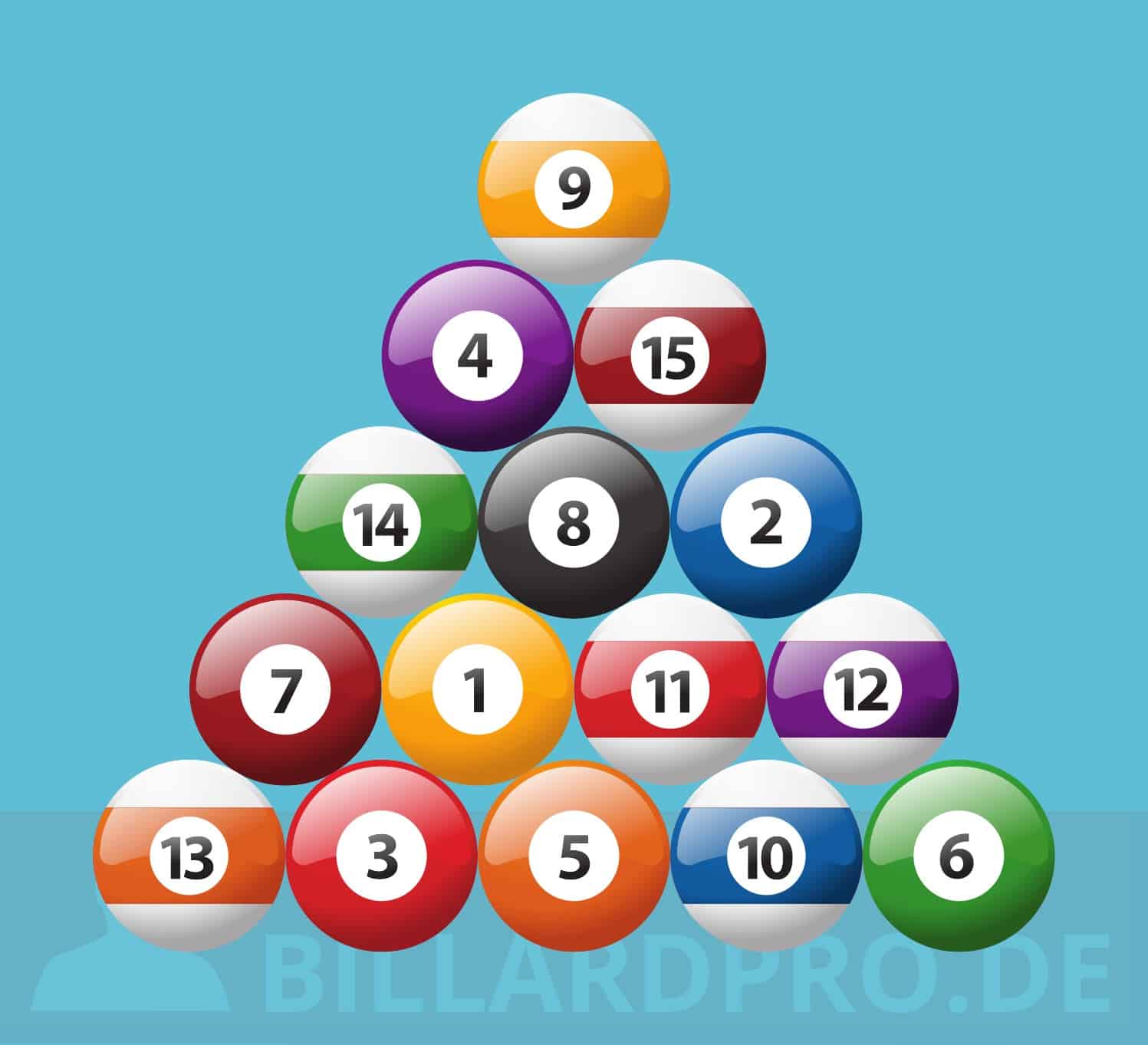 The foremost ball comes to the foot spot
The foremost ball comes to the foot spot - The eight ball is placed in the center of the rack
- A »solid« and a »striped« ball are placed at each of the two back corners
- The rest of the balls are placed randomly
Tip: For the perfect racking of the balls we recommend the Magic Ball Rack. And here you can find all products for racking the balls.
.Break shot
At the break, the cue ball may be placed anywhere in the kitchen. No particular ball must be hit first, and no ball must be called. If a ball is pocketed during the break, the break is automatically valid and the player breaking remains at the table. If no ball is pocketed, at least four object balls must hit one or more rails after the first contact of the cue ball with the rack for the break to be correct. If this is met, the shot changes and the other player takes over.
If no four balls touch a rail, the break is illegal. The player who did not break then has the choice
- to take over the picture as it lies anyway
- let the other player take the shot again
- to break himself
If the black eight is pocketed at the break, the player who has the next shot may decide whether to
- re-rack and take a new break shot
- the eight ball is placed on the foot spot and he takes over the picture as it is.
If both the cue ball and the black eight ball are pocketed, the opponent decides whether to re-rack or to take over the position with the black ball re-spotted. In this case, he then has »ball-in-hand« from the kitchen.
After the break shot, the player entitled to take over the position is basically free to choose which group he wants to take over. Even if only »stripes« is pocketed at the break, the player can choose the »solids« if he thinks they are better. The groups are only finally assigned when the player has pocketed a ball in accordance with the rules. As long as the groups have not been assigned, »mixed« combinations may be played, e.g. a »solid« may be played first and a called »stripe« may be pocketed in a called pocket. The eight may never be played first.
Fouls
After a foul, the other player always has ball-in-hand and may place the cue ball anywhere on the table for his next shot. The only exception is at the break. If the player commits a foul here, the other player may only move the cue ball inside the kitchen and may only play balls first that are outside the kitchen.
Object balls pocketed during a foul always remain in the pocket. A foul occurs when
- the cue ball is pocketed into a pocket
- the cue ball does not touch another ball
- the cue ball or an object ball jumps off the table
- a ball of the other group or the eight ball is hit first, as long as balls of the own group are still on the table
- after the first contact of the cue ball with an object ball, no ball touches at least one rail or is pocketed
- the cue ball is touched more than once during the shot (push shot foul)
- one or more balls are touched with the cue, body, clothing or in any other way
- a shot is made while at least one ball is still moving on the table
- at least one foot of the player does not touch the floor during the shot
Lost game due to incorrectly pocketing the eight ball
A game is considered lost when the black eight ball
- is pocketed while there are still object balls of the own group on the table
- is pocketed in a pocket other than the one called in each case
- the black eight is pocketed and a foul is committed at the same time
9-ball
9-ball is the classic among the rotation games, i.e. the games where the balls have to be hit and pocketed in ascending order. In order to make a correct shot, the object ball with the lowest number of the balls remaining on the table must always be hit first. If this is fulfilled and any object ball is pocketed, the player’s turn continues.
Objective of the game
The winner of a 9-ball game is the player who sinks the 9 ball with a correct shot. It does not matter whether it is the last object ball to drop with a normal shot, a valid combination over another ball, or by pure chance, as long as the rules for a correct shot are met. Potting the 9 ball on the break also automatically leads directly to winning the game if the break was executed correctly. Furthermore, a game can be won if the opponent commits a foul in three consecutive shots (see Three-Foul Rule).
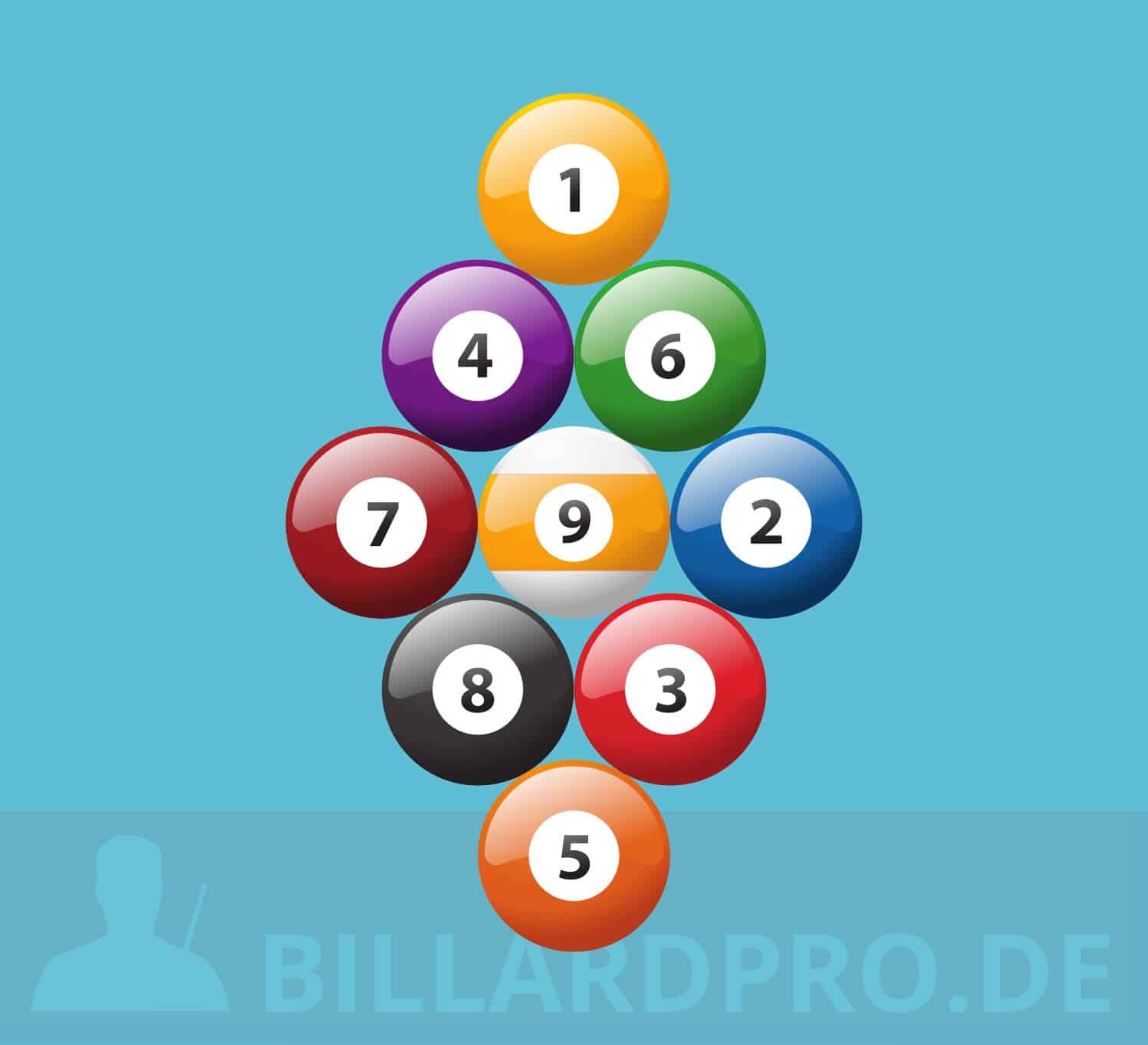 How to set up the balls
How to set up the balls
- The balls 1-9 are racked as a rhombus
- The one comes to the front
- Nine goes in the middle
- The rest of the balls are placed randomly
- In the standard variant, the one is placed at the foot spot. Depending on the tournament regulations, the nine can also be placed on the foot spot, especially in professional play, and the rack can thus be built up higher.
Tip: For the perfect racking of the balls we recommend the Magic Ball Rack. And here you can find all products for racking the balls.
.Break shot
At the break shot, the cue ball may be placed anywhere in the head area. The one in front must be hit first, otherwise it is a foul.
If an object ball is pocketed during the break, the break is automatically valid and the player making the break remains at the table. If no ball is pocketed, at least four object balls must hit one or more rails after the first contact of the cue ball with the rack for the break to be correct. If this is met, the shot changes and the other player takes over as it lies.
If no four balls touch a rail, the break is illegal. The player who did not take the shot then has the choice
- to take over the picture as it lies anyway
- let the other player take the shot again
- take the shot himself
Kitchen Rule (3-point rule)
In addition to the standard rules, many 9-ball events use the Kitchen Rule or 3-point rule. According to this rule, after the break, at least three object balls must run back into or through the kitchen for a correct break to occur. It is sufficient if the head string is touched, the ball does not have to cross it completely. Pocketed balls are automatically deducted from the 3-point rule. So if one ball is pocketed, only two have to go into the kitchen. If two balls are pocketed, only one has to go into the kitchen. If three or more balls are pocketed, the Kitchen Rule is automatically fulfilled. All other combinations mean an »Illegal Break«. If such an illegal break occurs, the player entitled to take over can decide whether to take over the situation or to let the player who caused the illegal break continue to play. If the player takes over, a correct shot must then be made on the lowest ball remaining on the table. If the shot is returned, the person who caused the illegal break may also continue the game with a »push-out«.
Push-out
On the first shot after the break, the eligible player may play a push-out. This option is useful when a correct shot on the lowest ball is not possible or difficult. A push-out is a free shot, so to speak, for which no rules apply. The cue ball only has to stay on the table, otherwise it is a foul. However, no rail needs to be touched and no object ball needs to be touched. The cue ball can be pushed back or forward a few centimeters. After the push-out, it is up to the other player to decide whether to take over the newly created position or to return the game to the player of the push-out. It is therefore advisable not to leave too easy a situation for the opponent but also not too difficult, otherwise you will usually have to continue playing yourself.
A push-out must be clearly called to the opponent before it is executed.
Foul shots
A foul occurs when
- the cue ball is pocketed into a pocket
- the cue ball does not touch another ball
- the cue ball or an object ball jumps off the table
- a ball other than the lowest ball on the table is contacted first
- after the first contact of the cue ball with an object ball, no ball touches at least one rail or is pocketed
- the cue ball is touched several times during the shot (push shot foul)
- one or more balls are touched with the cue, body, clothing or in any other way
- a shot is made while at least one ball is still moving on the table
- at least one foot of the player does not touch the floor during the shot
Three-Foul Rule
If a player commits a foul in three consecutive shots, he has lost the game. It is important that before committing a possible third foul, he is clearly warned by his opponent (or by the referee) that he has already committed two consecutive fouls and that the game would be lost if he committed another foul. If this warning is not given, the third foul will only have the usual effects of a normal foul.
10-ball
10-ball is a further development of 9-ball and in contrast to it a called-shot game. Basically, before each shot, the player must announce which ball is to be pocketed in which pocket. In the case of obvious shots, no announcement is necessary.
The game is played with balls from 1 to 10. In order to execute a correct shot, the object ball with the lowest number of the balls remaining on the table must always be played first. If this is fulfilled and the called object ball is pocketed into the called pocket, the player’s turn continues.
Objective of the game
The winner of a 10-ball game is the player who sinks the last ball on the table - the 10 - into the called pocket with a correct shot. Furthermore, a game can be won if the opponent commits a foul in three consecutive shots (see Three-Foul Rule).
Sinking the 10 ball early
If the 10 ball is pocketed while other balls are still on the table, it is re-spotted. Before the next shot is made, the ball is racked on the foot spot. If this is blocked by other balls, the 10 ball is placed as close as possible to the foot spot from below without touching any other ball.
If the 10 ball is pocketed prematurely during the break or with a correctly called combination shot, the player may continue his shot after the 10 ball has been re-spotted. If the 10 ball was pocketed without being called, the other player may decide whether to take over the position or let the opponent continue.
Potting balls not called
If the called ball is pocketed correctly during a shot, any number of additional balls may be pocketed as well. These remain in the pockets and the player keeps shooting with a shot at the lowest ball remaining on the table. The only exception is the 10 ball, which is racked again after a premature pocketing.
If, during a shot, the called ball is not pocketed, but a ball is pocketed without being called correctly, this ball also remains in the pocket and the other player may decide whether to take over the position or to let the opponent continue playing. Balls that were either not nominated at all or fell into a pocket other than the nominated pocket are considered to have not been pocketed correctly.
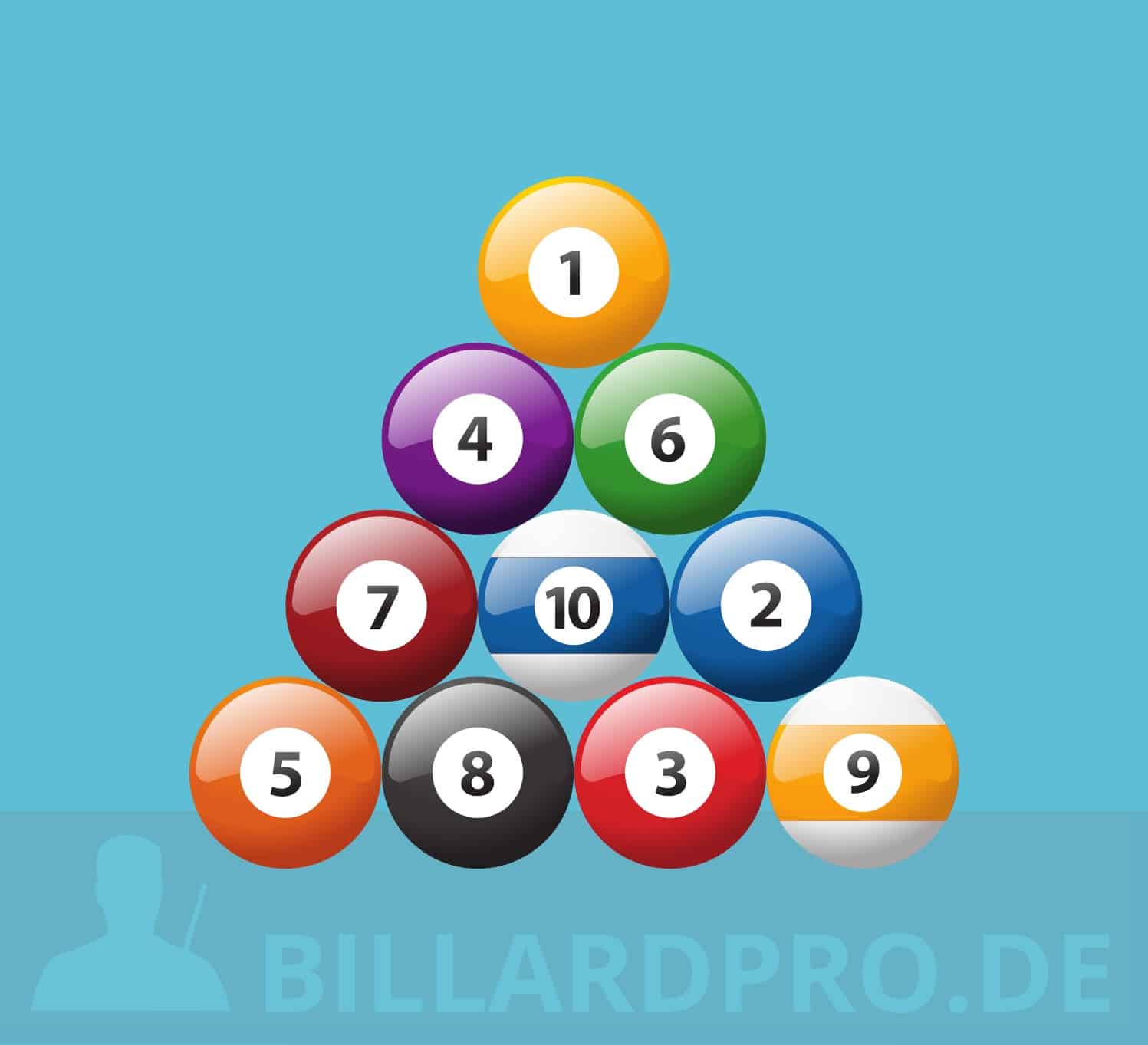 How to set up the balls
How to set up the balls
- balls 1-10 are set up as a triangle.
- The one comes at the very front
- The ten goes in the middle
- The rest of the balls are placed randomly
Tip: For the perfect racking of the balls we recommend the Magic Ball Rack. And here you can find all products for racking the balls.
.Break shot
At the break shot, the cue ball may be placed anywhere in the head area. The one ball in front must be hit first, otherwise it is a foul.
If an object ball is pocketed during the break, the break is automatically valid and the player making the break remains at the table. If no ball is pocketed, at least four object balls must hit one or more rails after the first contact of the cue ball with the rack for the break to be correct. If this is met, the shot changes and the other player takes over as it lies.
If no four balls touch a rail, the break is illegal. The player who did not take the shot then has the choice
- to take over the picture as it lies anyway
- let the other player take the shot again
- take the shot himself
Kitchen Rule (3-point rule)
In addition to the standard rules, some 10-ball events use the Kitchen Rule or 3-point rule. According to this rule, after the break, at least three object balls must run back into or through the kitchen for a correct break to occur. It is sufficient if the head string is touched, the ball does not have to cross it completely. Pocketed balls are automatically deducted from the 3-point rule. So if one ball is pocketed, only two have to go into the kitchen. If two balls are pocketed, only one has to go into the kitchen. If three or more balls are pocketed, the Kitchen Rule is automatically fulfilled. All other combinations mean an »Illegal Break«. If such an illegal break occurs, the player entitled to take over can decide whether to take over the situation or to let the player who caused the illegal break continue to play. If the player takes over, a correct shot must then be made on the lowest ball remaining on the table. If the shot is returned, the person who caused the illegal break may also continue the game with a »push-out«.
Push-Out
On the first shot after the break, the player entitled to take the shot may play a push-out. This option is useful when a correct shot on the lowest ball is not possible or difficult. A push-out is a free shot, so to speak, for which no rules apply. The cue ball only has to stay on the table, otherwise it is a foul. However, no rail needs to be touched and no object ball needs to be touched. The cue ball can also be pushed back or forward a few centimeters. After the push-out, it is up to the other player to decide whether to take over the newly created position or to return the game to the player of the push-out. It is therefore advisable not to leave too easy a situation for the opponent but also not too difficult, otherwise you will usually have to continue playing yourself.
A push-out must be clearly called to the opponent before it is executed.
Fouls
A foul occurs when
- the cue ball is pocketed into a pocket
- the cue ball does not touch another ball
- the cue ball or an object ball jumps off the table
- a ball other than the lowest ball on the table is contacted first
- after the first contact of the cue ball with an object ball, no ball touches at least one rail or is pocketed
- the cue ball is touched several times during the shot (push shot foul)
- one or more balls are touched with the cue, body, clothing or in any other way
- a shot is made while at least one ball is still moving on the table
- at least one foot of the player does not touch the floor during the shot
Three-Foul Rule
If a player commits a foul in three consecutive shots, he has lost the game. It is important that before committing a possible third foul, he is clearly warned by his opponent (or by the referee) that he has already committed two consecutive fouls and that the game would be lost if he committed another foul. If this warning is not given, the third foul will only have the usual effects of a normal foul.
14.1 continuous / Straight Pool
14.1 continuous is the original form of pool and in the USA, mainly known as »straight pool«, still for many billiard fans the supreme discipline of the sport. It is played with a full set of balls from 1-15 and is a called-shot game. All object balls are of equal value. If a ball is pocketed with correct announcement of ball and pocket, the player gets a point. If other balls are pocketed besides the called ball, they also count one point each. The player remains at the table and can continue his shot until he misses a called shot, voluntarily quits with a safety, or wins the game.
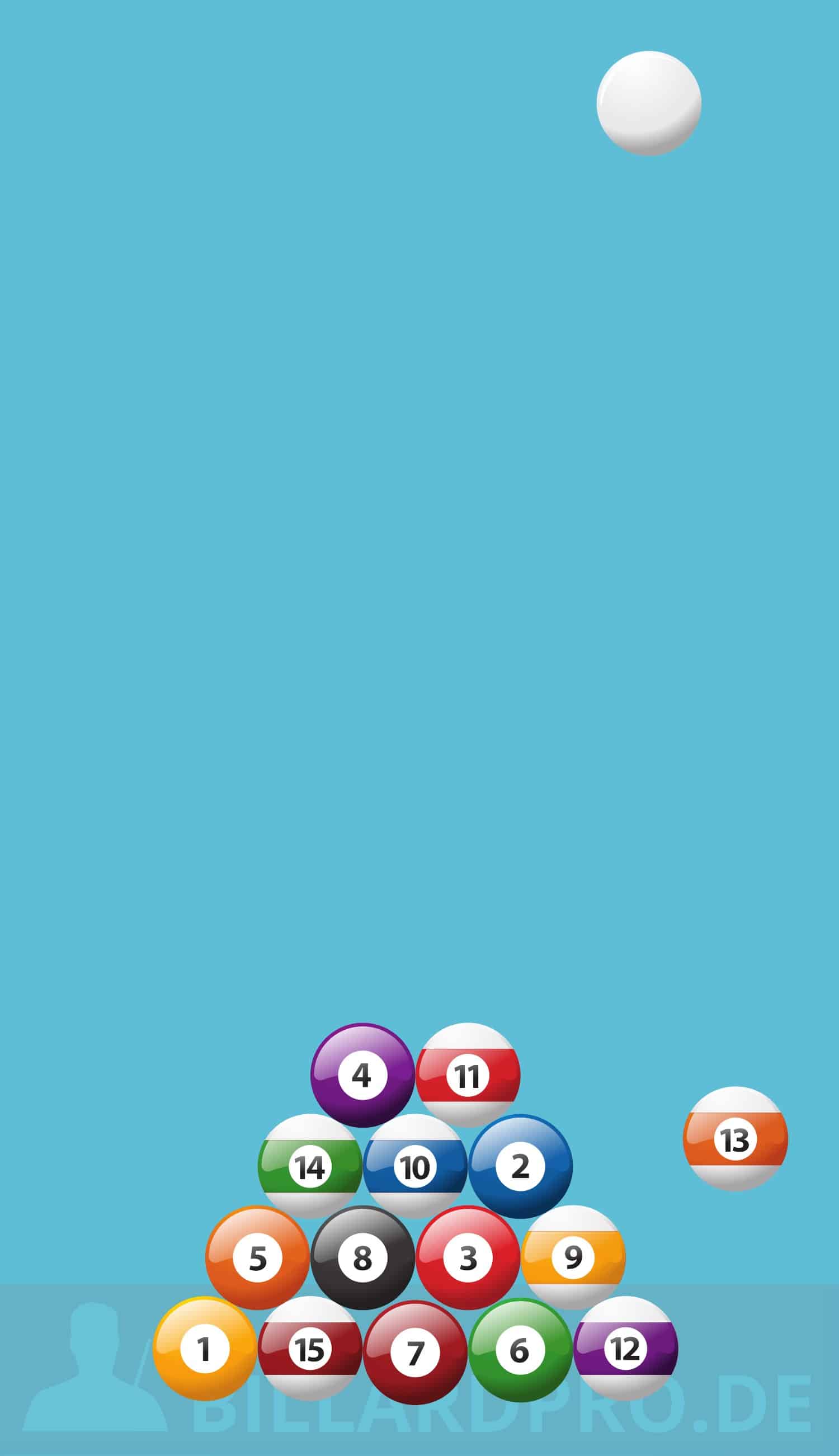 When there is only one object ball left on the table, the other 14 balls are re-racked into a triangle with only the top ball missing, which would be exactly on the foot spot. The remaining object ball and the cue ball remain in the positions where they came to rest after the last shot and the player may continue the game.
When there is only one object ball left on the table, the other 14 balls are re-racked into a triangle with only the top ball missing, which would be exactly on the foot spot. The remaining object ball and the cue ball remain in the positions where they came to rest after the last shot and the player may continue the game.
The trick now is to use a correct shot to reopen the triangle and allow play to continue. Classically, this is attempted by potting the last free ball and then running the cue ball into the remaining 14 balls to break them up. However, it would be just as possible, though infinitely more difficult, to call and pocket a ball from the closed triangle into a specific pocket.
As long as a correct shot pockets the called ball into the called pocket, the player may continue his series indefinitely. Hence the name 14.1 »continuous«. So it is also possible and not unusual in professional circles that one player hardly or not at all comes to the table because the other one pockets his 100 balls in a row. The unofficial record series of a player is 714 pocketed balls.
Objective of the game
The objective of the game is to score a set number of points or a number agreed upon before the game. The usual target is 100 points. In the professional field, longer distances are also played. Shorter distances (50, 60, 75) are recommended for beginners, recreational players and play in the lower classes.
To limit the time of play, it is also common to limit the number of innings (=visits to the table) per player. For example, 30-40 innings are common as a limit for a Race to 100. Once both players have completed their 40 innings and neither player has reached the draw goal, the current score is used to determine the winner.
If the score is tied when both players have completed their last inning, the game is extended for five innings. If there is still no winner, the game is extended by one inning per player until a decision is made. The game situation on the table always remains as it is, it is not rebuilt in the extra time.
How to set up the balls
- Balls 1-15 are set up as a triangle. The positions of the balls do not matter and are random. The foremost ball is on the foot spot.
- When re-racking the 14 balls balls between the racks, the balls are also randomly positioned built up as a triangle. The foremost position on the foot spot remains empty.
Here you will find all products for racking the balls.
.Specifics of in-game racking
If the cue ball or the last object ball remaining on the table obstructs the re-racking of the 14 balls because they block the »triangle«, the following rules are applied.
- If both the cue ball and the object ball are in the triangle, all 15 object balls are racked into a complete triangle and the cue ball must be played with free position selection (ball-in-hand) from the kitchen area.
- If only the remaining object ball is in the triangle, it is spotted on the head spot. If the head spot is blocked by the cue ball, it is placed on the center point.
- If the cue ball lies in the triangle, the game is continued with free choice of position (ball-in-hand) in the kitchen.
- Exception: The remaining object ball is also in the kitchen. In this case, the cue ball must be racked on the head spot. If this is occupied by the object ball, the cue ball is placed on the center spot.
| Position of the 15th ball | Position of the cue ball | ||
| In the triangle | Neither in the triangle nor on the head spot | On the head spot | |
| In the triangle | 15th ball: foot spot Cue ball: kitchen |
15th ball: head spot Cue ball: stays where it is |
15th ball: center spot Cue ball: stays where it is |
| Pocketed | 15th ball: foot spot Cue ball: kitchen |
15th ball: foot spot Cue ball: stays where it is |
15th ball: foot spot Cue ball: stays where it is |
| In the kitchen, but not on the the head spot | 15th ball: stays where it is Cue ball: head spot |
||
| Neither in the kitchen nor in the triangle | 15th ball: stays where it is Cue ball: kitchen |
||
| On the head spot | 15th ball: stays where it is Cue ball: center spot |
||
Source: Wikipedia
Re-spotting individual object balls
A pocketed object ball is re-spotted when
- a foul was committed on the shot
- the called ball was not pocketed on the same shot
- the ball was pocketed when a safety was executed
The object ball in question is always racked on the footing point. If this is blocked, the ball is placed in the center as close as possible to the foot spot from the foot rail. If several balls are to be racked again after a shot, each one is racked in turn according to the above principle.
Break shot
At the break shot, at least two object balls and the cue ball must touch a rail or a called object ball must be pocketed for a correct break shot to occur. Otherwise, the player who took the break shot will receive two penalty points and the opponent can either take over the position or call for a re-set. In this case, he can let the opponent take the break shot again or take over the break shot himself. If the same player continues with a second break shot, it still counts towards the first inning. Thus, multiple break shot fouls in a row are possible, the points of which are all attributed to the first inning. For example, a score of -10 (=five break shot fouls) in the first inning is possible. A »normal« foul (e.g. cue ball pocketed) is penalized with only one minus point and cannot result in a new break.
Fouls
A foul occurs when
- the cue ball is pocketed
- the cue ball does not touch another ball
- the cue ball or an object ball jumps off the table
- after the first contact of the cue ball with an object ball, no ball touches at least one rail or is pocketed
- the cue ball is touched several times during the shot (push shot foul)
- one or more balls are moved with the cue, body, clothing or in any other way
- a shot is made while at least one ball is still moving on the table
- at least one of the player’s feet does not touch the floor during the shot.
After a foul, the game is generally continued with the game situation unchanged. There is no ball-in-hand. Only if the cue ball is pocketed or leaves the table, the other player may continue with free choice of position from the kitchen.
Minus points
A foul is always penalized with a minus point. The score of a player can therefore be negative. Three fouls in a row result in 15 minus points. In this case, the player who has already committed two fouls in a row must be warned before his next shot that he has already accumulated two fouls.
If a player commits a third foul in a row despite the warning, first one minus point is calculated for the foul and then an additional 15 minus points are deducted. Then the complete rack is re-racked and the player who committed the three fouls must continue the game with a correct break shot (see break shot).
One Pocket
One Pocket is one of the most popular pool variations in the USA and especially popular in gambler circles. Each player is assigned one of the two pockets at the foot of the table and can only score points by pocketing balls into that pocket. The other four pockets are neutral. Nothing needs to be called. Each ball pocketed into one’s own pocket with a correct shot counts for one point.
Objective of the game
The player who has eight points first wins a game. An overall scoring goal for a match can be agreed upon in advance. For a match, races to 3 or 5 are common.
How to rack the balls
The balls 1-15 are set up as a triangle. The positions of the balls do not matter and are random. The foremost ball is placed on the foot spot.
Here you will find all products for racking the balls.
.Break shot
Before the break, the starting player must name which of the two pockets at the foot of the table he chooses for his balls. The other player is automatically assigned the other pocket. In practice, the announcement is often left out, since in the classic one-pocket opening shot, the majority of the balls are always clearly moved in the direction of one pocket and it is obvious from this which pocket the player chooses. On the break from the left, the player then plays the right pocket and vice versa.
The game is always played with alternating break. Before each new rack, the player making the break can choose which pocket he wants to play.
At the break, the cue ball may be placed in the entire kitchen and must be played out of it. Either an object ball or a rail may be hit first. However, at least one object ball must be hit in any case and after this contact some ball must still hit at least one rail, so that a correct shot has been made. If a ball is pocketed during the break shot, the break shot is also correct in principle. However, in these cases, re-racking is sometimes done and the break shot is taken again.
If the above conditions are not met, it is a foul and the player gets a minus point. The other player must nevertheless take the picture as it lies. There is no ball-in-hand. If the cue ball is pocketed at the opening shot, the other player must continue the game by a shot with a free position from the kitchen.
The game
A player may continue his shot as long as he pockets one or more balls into his own pocket with correct shots. If a ball is pocketed - intentionally or unintentionally - in a neutral pocket or the opponent’s pocket and a ball is not pocketed in the own pocket at the same time, the righ to shoot changes. Neutrally pocketed balls are put back after the shot. Balls pocketed in the opponent’s pocket count one point for the opponent. The only exception is when an opponent’s ball is pocketed and a foul is committed, either by pocketing the cue ball or the cue ball flying off the table. Then the pocketed ball is re-spotted from the opponent’s pocket.
If a player pockets both his last ball and the opponent’s last ball correctly in one shot, the executing player wins the game.
There are no called safeties or safety shots. If a ball is pocketed in the correct pocket, the player must continue his shot.
Jump cues are not allowed in One Pocket. However, it is allowed to execute jump shots with the complete cue.
Fouls
Each foul results in a minus point. The player who committed the foul must therefore pass a ball from his pocket and put it back on. Balls pocketed during a foul must be racked again immediately afterwards, along with the fouling player’s minus ball. Balls pocketed in the opponent’s pocket are only set up again if the cue ball was pocketed or carried off the table at the same time. For other fouls, such as a push shot foul or an illegal ball contact, the opponent’s ball remains in the pocket and counts.
If a player has no balls in his pocket to »pay« a foul, he owes a ball. This should definitely be recorded in some form by writing it down or marking it. Balls owed must be replaced as soon as possible, but only ever at the end of an inning. Only when all debts have been paid can the player begin to collect balls in his pocket.
Intentional fouls are a common tactical tool in One Pocket. However, a correct shot must always be made, even if the cue ball is intentionally sunk, moved only a millimeter, or nothing is attempted to hit another ball. After an irregular shot, the player entitled to take the shot can decide whether to take over the situation on the table or to restore the picture from before the foul.
Three-foul rule
After three consecutive fouls, the game is considered lost. However, as in rotational games, a player must be advised by the referee or opponent that he already has two fouls before taking the next shot and committing a third foul. In practice, the three-foul rule is often waived if both players agree.
Re-spotting balls
Balls to be re-spotted are always placed directly on the foot spot. If this is not completely free, the ball is placed from the foot rail on the line to the foot spot as close as possible without touching another ball. When everything from the foot spot to the foot rail is blocked, the ball is set up above the foot spot.
Balls are always set up at the end of an inning. The only exception to this rule is if a player pockets the last ball on the table without either player reaching his or her rack, all balls to be racked again are immediately racked and the player may continue his or her shot.
Handicaps
It is common practice, especially in gambler circles, to play One Pocket with handicaps to compensate for differences in skill levels. For example, it can be agreed that one player needs his eight balls normally to win, but the other only needs six (8-6) or the better player even needs to pocket more balls (e.g. 10-6). If more than the 15 available balls are needed to reach the draw goals, the player with the higher goal must re-set pocketed balls at the end of his shot until the goal is reachable for both players. So, in a 12-8 handicap, the better player would have to put his first four correctly pocketed balls back on. But the scored points count, of course.
Bank Pool
In bank pool, pockets may only be pocketed over the rail, as so-called bank shots. In principle, any object ball on the table may be played and all six pockets are available. The objective of the game is to reach the score target first with correctly called and pocketed bank shots. A pocketed ball counts for one point.
9-ball banks
In 9-ball banks, any nine balls are racked to form a rhombus, just like in classic 9-ball. The first player to reach five points is the winner.
Full rack banks
In Full Rack Banks all 15 balls are built up as a triangle like in the classic 8-ball. The first player to reach eight points is the winner.
Tip: For the perfect racking of the balls we recommend the Magic Ball Rack. And here you can find all products for racking the balls.
.The game
Bank Pool is a called-shot game. For each shot, the ball to be pocketed, the pocket targeted, and the ball’s path of travel including used rails must be called. In obvious situations, such as the classic »one rail bank in the middle«, no announcement is necessary. If a ball accidentally is pocketed on a path other than the intended path, it has not been pocketed correctly and will be put back on. There is no penalty, the right to shoot changes.
As long as a player pockets balls correctly as called, he can continue his shot. Only one point can be scored per shot. If additional balls are pocketed in addition to a correctly pocketed ball, they are put back on at the end of the shot. An inning ends when no ball is correctly pocketed, a foul is committed, or the score target is reached.
For a bank shot to be legally pocketed and count a point, the following requirements must be met:
- The ball must be pocketed »cleanly.« No other ball may be touched on the way into the pocket.
- The cue ball must always hit the object ball to be pocketed first. Combinations and carom shots are not allowed
- The cue ball must hit the object ball before it hits a rail. The object ball may not be played over a rail. No rail-first shots.
- The cue ball may only touch the object ball once on its way into the pocket. Any further touch will result in the ball not being pocketed correctly and being put back on the court
In addition to the official rules, there are widespread variations that make the game more interesting or even easier. The most popular rule is that you can pocket balls without touching the rail if you hit at least three rails before you hit the object ball. In this way, you can also do something with balls that are close to a pocket and cannot be played as a bank shot. Another variant allows rail-first shots if a bank shot is pocketed afterwards.
Break shot
9-ball Banks
The rack is set up as a rhombus, as in 9-ball. The ball in front is on the foot spot and must be hit first during the break. For a legal break to occur, at least one ball must pass over the center into the other half of the table.
Full Rack Banks
The 15 balls are racked normally for the break. The foremost ball is on the foot spot. No particular ball must be hit first. For a legal break to occur, at least two object balls must hit a rail after the cue ball has touched the first object ball.
The goal in both cases is to pocket at least one ball on the break. If a ball is pocketed on the break, the player making the break may continue his shot. However, the pocketed balls do not count as points and are put back on at the end of the inning. If no ball is pocketed, the right to shoot changes and it is the other player’s turn.
If the criteria for a legal shot are not met, the other player can either take over the situation or ask the other player to take another shot. An illegal break shot is not a foul and is not penalized.
Fouls
A foul occurs when
- the cue ball is pocketed into a pocket or bounces off the table
- after the cue ball has touched the first object ball, not at least one ball is pocketed or touches a rail
Each foul leads to the end of the inning and results in a minus point. If a ball is correctly pocketed in the same shot, it does not count and is put back on. If a player has no points on the credit side at the time of a foul, he also gets a minus point and then owes one or more balls. The debt is settled by putting correctly pocketed balls back on at the end of an inning.
Incidentally, if an object ball flies off the table during a correct shot, it is not a foul and the ball is put back on.
If the cue ball remains on the table when a foul occurs, the other player must take over the situation as he finds it. There is no ball in hand.
If the cue ball leaves the table when a foul occurs, the ball-in-hand from the kitchen continues. The player entitled to take the cue ball must play forward from the kitchen. In the case that all remaining object balls are in the kitchen and therefore no correct shot is possible, the ball closest to the head string is taken away and placed on the foot spot.
Re-spotting of balls
Incorrectly or illegally pocketed as well as owed balls are, if possible, placed on the foot spot or in a direct line below it in the direction of the foot rail.
Balls are always re-spotted at the end of an inning. The only exception is when there are no more object balls on the table after a correctly pocketed ball, but the game is not yet decided. In this case, all balls that can be re-spotted are immediately re-spotted.
Rotation
Rotation is one of the oldest games in pool and is played in different variations almost everywhere on the globe. It is considered the supreme discipline in many places and is recommended by some professionals as a training game to improve their own billiards game.
The game is played with a complete set of balls from 1 to 15. Just as in 9- or 10-ball, the lowest ball remaining on the table must always be hit first in order to make a correct shot.
Objective of the game
In rotation pool, each ball has the value corresponding to its number. Thus, one is worth one point, four is worth four points, and 15 is the most valuable ball. The goal of the game is to reach a certain number of points. Since there are a total of 120 points on the table at the beginning, typically 61 is the number of points that wins a game. However, handicaps can be agreed upon so that, for example, one player needs 70 and the other only 50.
If there is a tie of 60:60, the player who last pocketed a ball correctly and was second to reach 60 is typically declared the winner.
The game
Rotation Pool is not a called-shot game. As long as the lowest ball on the table is hit first with the cue ball and there is no foul, all balls pocketed on that shot count for the player whose turn it is. A shot ends when either no ball has been pocketed, a foul has been committed, or the run-out target has been reached.
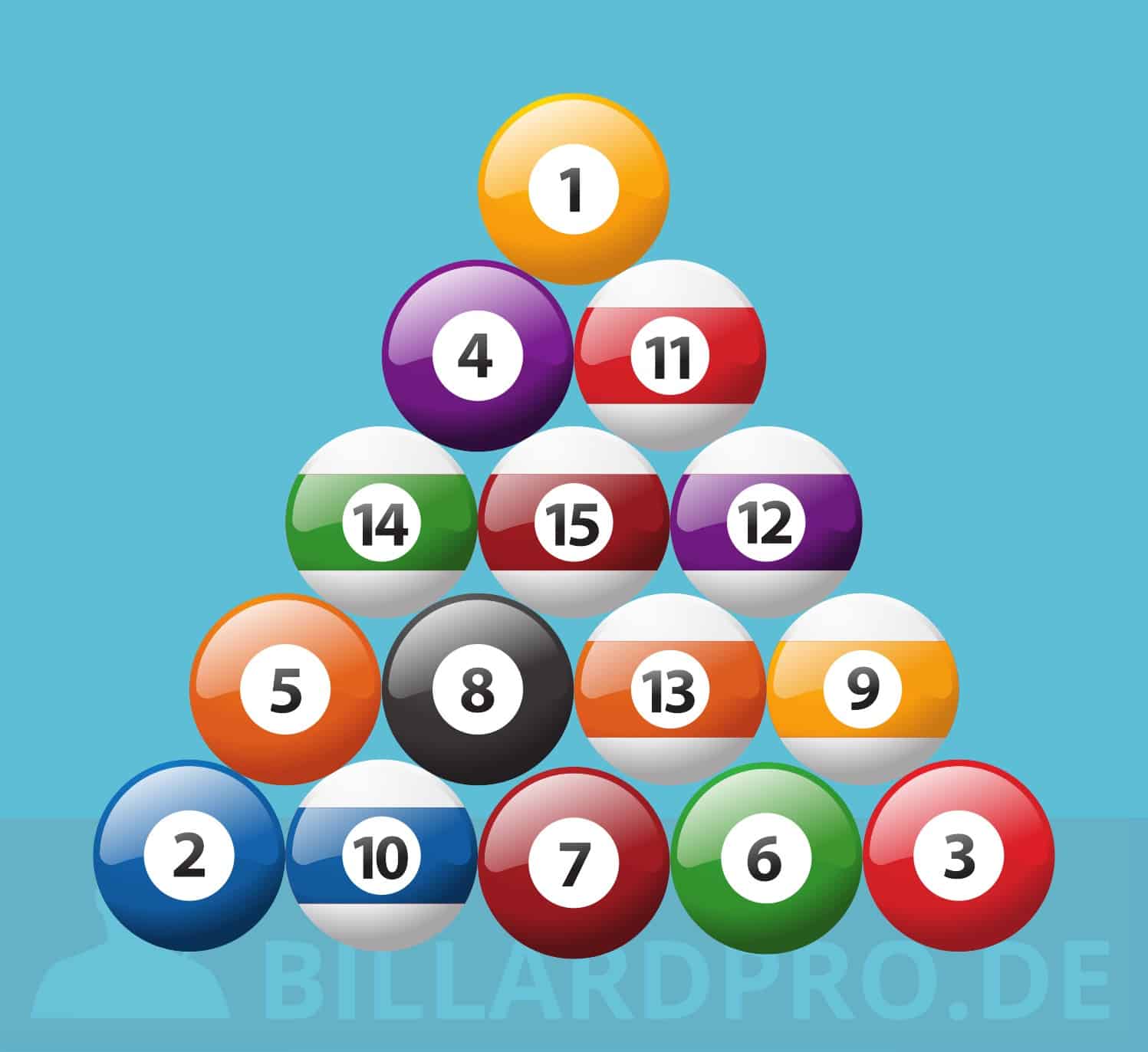 How to set up the balls
How to set up the balls
When racking, four balls have fixed positions. The one goes to the very front on the base, the two and the three to the back two corners of the rack and the 15 as the most valuable ball to the center. All other balls are placed randomly.
Tip: For the perfect racking of the balls we recommend the Magic Ball Rack. And here you can find all products for racking the balls.
.The break shot
To execute a correct break, at least one ball must be pocketed or four object balls must run into at least one rail. Otherwise, the same rules apply as in the entire game. The lowest ball, i.e. the one, must be hit first. If there is no foul and a ball is pocketed, the player continues his turn, otherwise the shot changes.
If the criteria for a legal break are not met, the other player can decide whether to
- take over the picture as it lies and continue playing with ball-in-hand from the kitchen
- set up again and break himself.
If, on the other hand, there is a break foul because the cue ball is pocketed or bounces off the table, play is continued in any case with ball-in-hand from the kitchen. However, the player entitled to take the shot may pass and force the player who committed the break foul to continue play with the situation as found.
Fouls
A foul is committed when
- the cue ball does not touch the lowest ball on the table first
- does not touch any ball at all
- the cue ball is pocketed or flies off the table
- after the contact of the cue ball with the object ball, no ball is pocketed or hits a rail
- an object ball flies off the table
A special feature is the »one-ball-safety« rule. A player is allowed to play a safety only twice per rack, where the object ball to be played is simply rolled to the nearest rail, so as not to give the opponent an easy shot. The third »one-ball safe« in a rack thus also results in a foul.
All other common safe variations, however, where multiple balls are moved or multiple boards are hit, are not limited and are allowed at any time.
Three consecutive fouls by a player in a rack will result in the loss of the game.
After a foul, the player entitled to take the shot generally has the choice of taking the shot himself or allowing the fouling player to continue playing. If there is a foul where the cue ball left the table, play continues with ball-in-hand from the kitchen. However, this shot can also be given to the player who committed the foul.
In the case of ball-in-hand from the kitchen, it is mandatory to play the cue ball forward from the kitchen. If the lowest remaining object ball is in the kitchen and a direct hit is therefore impossible, this ball is placed on the foot spot.
Re-spotting balls
Balls that jump off the table or are pocketed in the course of a foul are put back on. In principle, the balls are placed on the foot spot or in a direct line to the foot rail as close as possible to the foot spot.
Variations
Filipino Rotation
In the Philippines, rotation is the most popular pool variation besides 10-ball. There are some special rules to consider.
- Jump cues are not allowed
- In the case of kick shots, i.e. when one or more rails are hit first and then the object ball to be played is hit, no other rail needs to be touched after contact.
- If a player lies completely save on the ball to be played and cannot play it directly, he can forego an attempt and offer the opponent a spot shot instead. The ball to be played is then placed on the foot spot and the other player continues to play with ball-in-hand from the head area.
- After a no-hit foul, that is, when a player has failed to hit the lowest ball on the table with a correct shot, the player entitled to take the shot can either take it as it lies or take a spot shot himself. This is done by again placing the lowest object ball on the foot spot and playing ball-in-hand from the head spot.
- If, after a break foul, the lowest remaining object ball is in the head area, it is also placed on the foot spot and the player entitled to take a spot shot continues to play with ball-in-hand from the head area.
American Rotation
- In American Rotation, the balls do not have the value of their number as in regular rotation. The balls from 1-10 are worth one point and the balls from 11-15 are worth two points each. In this way, 20 points are always distributed in a rack and a total score of, for example, 50, 100 or 150 points is played.
- American Rotation is a called-shot game. Before each shot, the player must announce which ball is to be pocketed. If this is successful and more balls are pocketed, they count. Safety shots must also be called. If a ball is called and isn’t pocketed, the opponent can always refuse the shot. If a player announces a safety and a ball is pocketed, the opponent can also refuse. The dropped ball counts for the player who makes the next shot.
- The break shot is alternating and each player racks for himself. The player breaking always has ball-in-hand after his break, even if no ball went down on the break or even if the cue ball is pocketed. In case of a break foul, the breaking player still has ball in hand, but any balls dropped during the break count for the opponent.
- In case of a foul, the opponent receives ball-in-hand. Balls pocketed with a foul remain in the pocket and count for the opponent.
- Three-foul rule: As in 9- and 10-ball, the three-foul rule applies. Here, a player who has already committed two fouls in a row must be told before his next shot that he already has two fouls, so that the third foul can result in a free shot. If this happens, the other player may place the cue ball anywhere on the table and take a »free shot«, where any ball may be played first and all balls pocketed count for the player. If the cue ball is pocketed during this shot, there is no foul and the points still count. All other fouls are treated as normal fouls. After the free shot, the player has ball-in-hand again, but must then hit the lowest remaining ball as normal and call a ball or a safety.
-
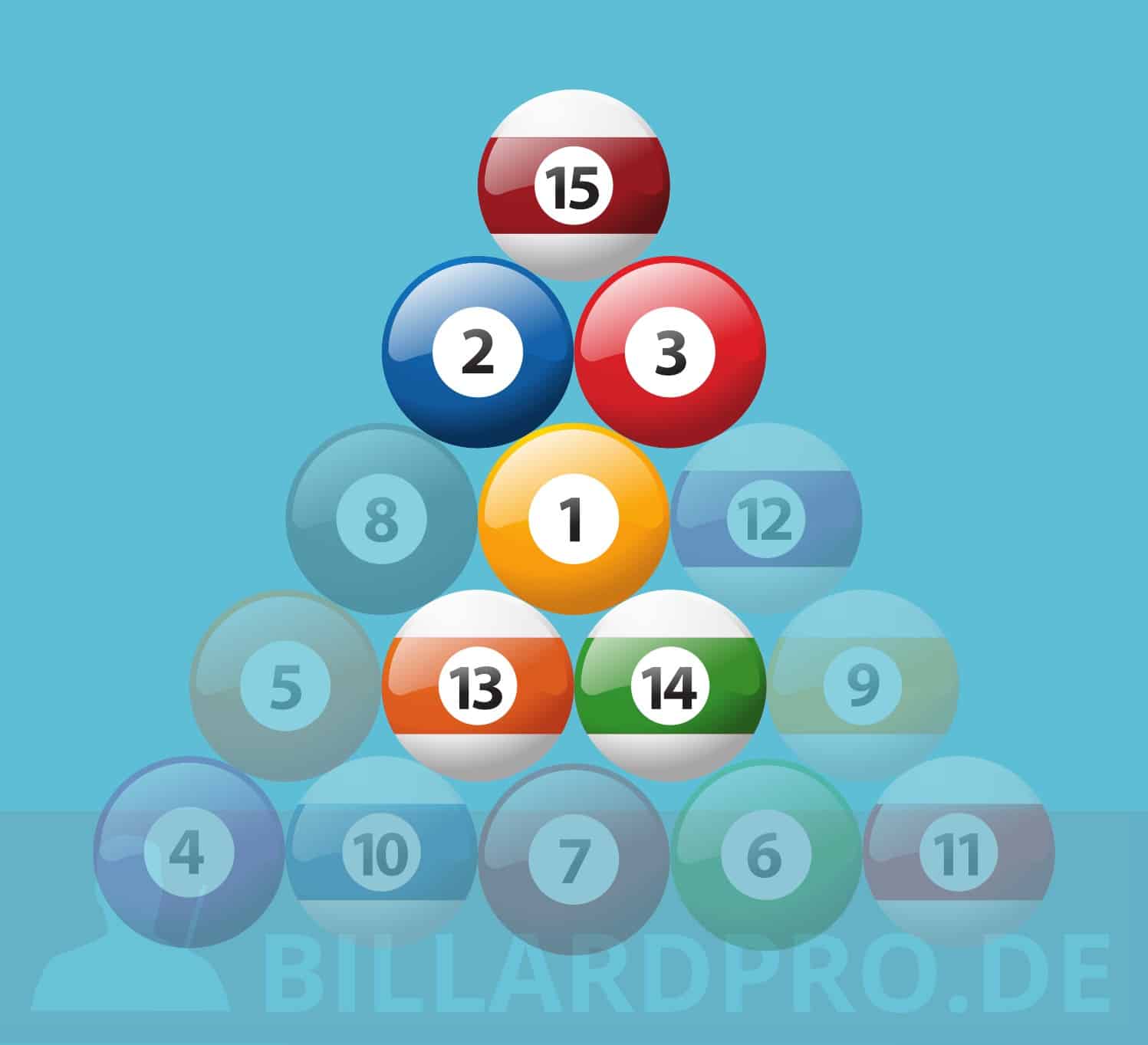 Racking: The 15 balls are built into a triangle as usual. The 15 lies as the foremost ball on the foot spot. In the second row are the two and the three, behind them in the middle of the rack is the one. The balls 13 and 14 lie in the fourth row and touch the one.
Racking: The 15 balls are built into a triangle as usual. The 15 lies as the foremost ball on the foot spot. In the second row are the two and the three, behind them in the middle of the rack is the one. The balls 13 and 14 lie in the fourth row and touch the one.

